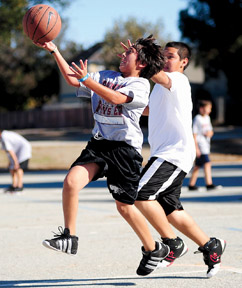
Healthy habits the focus of Childhood Obesity Awareness
Month
The YMCA of San Benito County is focusing on ways that families
can keep children healthy through a few changes to their daily
habits.
”
With all the different things going on in communities, it’s
really important to do more things as a family,
”
said Rochelle Callis, vice president of the Central Coast YMCA
north region.
”
Eating out or eating on the go, we might not be making the best
choices. It’s good to eat together, eat at home. We encourage
better eating and going for walks …
”
Healthy habits the focus of Childhood Obesity Awareness Month
The YMCA of San Benito County is focusing on ways that families can keep children healthy through a few changes to their daily habits.
“With all the different things going on in communities, it’s really important to do more things as a family,” said Rochelle Callis, vice president of the Central Coast YMCA north region. “Eating out or eating on the go, we might not be making the best choices. It’s good to eat together, eat at home. We encourage better eating and going for walks …”
September is National Childhood Obesity Awareness Month, an effort started last year when President Barack Obama signed a proclamation that noted the concerns that come along with the growing rate of children who are carrying extra weight.
In his 2011 proclamation, signed on Aug. 31, Obama noted that the rates have tripled nationwide in the last two decades. According to the Centers for Disease Control and Prevention, nearly 20 percent of children ages 6 to 11 were obese based on 2008 statistics. At least 18.1 percent of children 12 to 19 were obese based on 2008 statistics.
The numbers are similar in San Benito County, according to a report by the California Center for Public Health Advocacy that notes that a third of local children are overweight or obese.
“This dramatic rise threatens to have far-reaching, long-term effects on our children’s health, livelihoods, and futures,” the president’s proclamation reads. “Without major changes, a third of children born in the year 2000 will develop Type 2 diabetes during their lifetimes, and many others will face obesity-related problems like heart disease, high blood pressure, cancer and asthma.”
Locally, Callis has been working with community partners on a grant from the Health Trust that has allowed the group to create a road map for making life healthier for San Benito children
“We came up with three areas we would like to continue to work on,” Callis said, of the six partners that will carry on the effort. “One is to improve the overall body mass index for elementary school-aged children. The other is to increase opportunities for children and families to engage in regular physical activity. It can be at home, at school, after school – anywhere in San Benito County. The other is to increase the number of children and youth that eat the recommended daily servings of vegetables and fruits.”
Callis said that there are a lot of things that local nonprofits and agencies can do to support the goals, but they will continue to look for outside sources of funding. She said one of the main things that came out of the effort is that the agencies are now planning to work together on different events, such as an upcoming Walk to School Week.
“It’s great to have someone help us organize and continue to move forward with our process,” Callis said.
In addition to the grant for the road map, the YMCA is continuing to partner with local schools to offer after school sports program. They offer an after school sports program for elementary school students, who can play even if their families are not a member of the YMCA. The same is true of a middle school sports program, which will be offered at Rancho San Justo and Marguerite Maze Middle Schools.
“We are working with our principals,” she said, of the YMCA’s effort to fill in a gap left last year when the Hollister School District eliminated middle school sports programs. “We are still giving it another chance.”
Callis said the agency is looking to offer boys’ and girls’ basketball for sixth-grade students at all the schools.
The programs are open to all students enrolled in the school and financial assistance is available for up to 50 percent of the program fee. The YMCA offers other fitness programs for which families have to be a member of the organization, such as a roller hockey league and karate.
“It gives youth an opportunity to get out and do something a little bit different,” Callis said.
The programs are offered after school so families have time for homework or other activities at home in the evenings.
The YMCA of the USA, as part of the Healthy Out-of-School Time Coalition, created national healthy eating and physical activity standards for after school programs, this summer. The recommendations include: serving fruits and vegetables (fresh, frozen or canned) as options instead of cake, cookies, candy and chips; offering water as the preferred drink during snack times instead of juices, punch boxes or soda; dedicating at least 20 percent or at least 30 minutes of morning or after school program time to physical activity (or 60 minutes for a full-day program); ensuring that daily physical activity time includes aerobic and age-appropriate muscle and bone strengthening and cardio respiratory fitness activities.
Callis said the local YMCA after school daycare programs have not implemented the new standards, but that they do try to offer healthy snacks and the children are given time to engage in physical activity outside.
“The big thing is, yes we do programming, but that’s not really what we are all about,” Callis said. “We are about trying to help families in whatever way we can. Right now, nationally, our focus is on health and wellness.”









